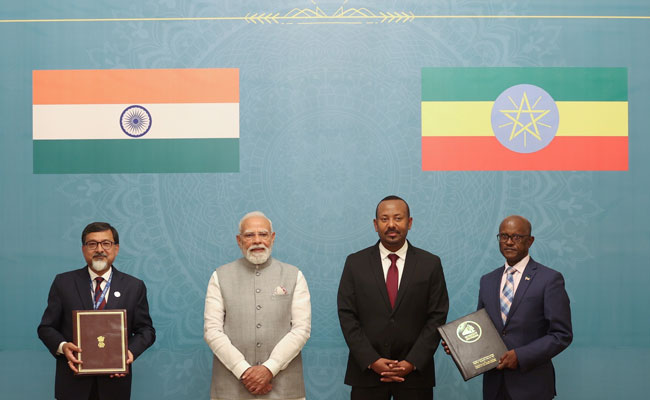New Delhi, May 22: Google on Tuesday celebrated the 246th birth anniversary of renowned social reformer Raja Ram Mohan Roy recognised as the "Father of the Indian Renaissance", who paved the way for a modern India.
Roy was a non-conformist to many a tradition he was born into on this day in 1772, in Radhanagar village in Murshidabad district of West Bengal.
Although born into a Hindu Brahmin family, where his father Ramkanto Roy, was a Vaishnavite, Roy at a young age left home, shunned orthodox rituals and idol worship and became a staunch supporter of monotheism.
Following his differences with his father, Roy went on a journey that took him far from his roots. He travelled extensively including in Tibet and the Himalayas.
He studied Persian and Arabic along with Sanskrit, which influenced his thinking about God. He read Upanishads, Vedas and the Quran and translated a lot of the scriptures into English.
When he returned home, his parents married him off in a bid to change his outlook. But Roy continued to explore the depths of Hinduism only to highlight its hypocrisy.
After his father's death in 1803 he moved to Murshidabad, where he published his first book Tuhfat-ul-Muwahhidin (A Gift to Monotheism).
Roy took a keen interest in European politics and followed the course of the French Revolution.
In 1814, he settled in Calcutta, and the following year he founded the Atmiya Sabha. In 1828, he established the Brahmo Samaj, which is considered to be one of India's first socio-religious reform movements.
However, his most significant contribution as a social engineer was towards women's rights. Nearly 200 years ago, when evils like -- Sati -- plagued the society, Roy played a critical role to bring about a change.
He opposed the regressive practice that forced a widow to immolate herself on husband's pyre.
The doodle on Roy, created by Beena Mistry, a designer based out of Toronto, shows Roy speaking at a public meeting with his detractors in the background. There is also the presence of a woman among the audience, this is at a time when the purdah system was rigidly followed.
He campaigned for equal rights for women, including the right to remarry and the right to hold property.
In 1830, he travelled to the UK as the Mughal Empire's envoy to ensure that Lord William Bentinck's law banning the practice of Sati was not overturned.
Roy was also one of the pioneers of Indian journalism. He published several journals in Bengali, Persian, Hindi and English to propagate social reforms.
Bengali weekly Samvad Kaumudi was the most important journal that he published. The Atmiya Sabha published an English weekly called the Bengal Gazette and a Persian newspaper called Miratul-Akbar.
Roy died in a village near Bristol in England on September 26, 1833 of meningitis, and was buried there.
Let the Truth be known. If you read VB and like VB, please be a VB Supporter and Help us deliver the Truth to one and all.
Addis Ababa (PTI): India and Ethiopia on Tuesday elevated their historical ties to a strategic partnership, as Prime Minister Narendra Modi held wide-ranging talks with his Ethiopian counterpart Abiy Ahmed Ali during which they discussed issues of bilateral and mutual interest.
Modi, who arrived here from Jordan on his maiden bilateral visit, was accorded a ceremonial welcome at the National Palace ahead of the bilateral talks, reflecting the vibrant India-Ethiopia relations rooted in shared history and a promising future.
"We are elevating India and Ethiopia relations to a strategic partnership. This step will provide new energy, new momentum and new depth to our ties," Prime Minister Modi said during the delegation-level talks.
He thanked PM Ali for his support in India's fight against terrorism. "The support of friendly countries in this struggle against terrorism holds great significance," Modi said.
"Today, we got the opportunity to deliberate on the key aspects of our cooperation, such as economy, innovation, technology, defence, health, capacity-building and multilateral cooperation. I am pleased that today, we have decided to double the student scholarship for Ethiopia in India," Modi said.
Modi said that India and Ethiopia have shared contact, dialogue, and exchange for thousands of years. The two countries, which are rich in languages and traditions, are symbols of unity in diversity, he added.
"Both countries are democratic powers committed to peace and the welfare of humanity. We are co-travellers and partners of the Global South. On international platforms, we have stood shoulder-to-shoulder," he said.
The two sides signed eight MoUs/agreements, including upgrading ties to 'Strategic Partnership', customs cooperation, establishing data center at the Ethiopian Foreign Ministry, UN Peacekeeping training cooperation, debt restructuring under G20, more ICCR scholarships and AI short courses for Ethiopians, and support for maternal and neonatal healthcare.
Modi said the African Union's headquarters in Ethiopia makes the country a meeting point of African diplomacy. "Inspired by the common vision of an inclusive world, in 2023, India ensured that the African Union became a G20 member," he said.
In 2023, during India’s G20 Presidency, the African Union was admitted as a permanent member of the G20.
Modi said that though this is his first visit, he felt a deep sense of belonging and warmth, reflecting the thousands of years of connection between the two countries.
On his part, Prime Minister Ali said the two countries share over thousands of years of connection through trade, diplomacy, education, culture and even in our food and traditions. "These ties continue to shape a deep friendship, collaboration and mutual respect between our people," he said.
"We also appreciate your consistent message that Africa's priorities must lead the partnership. These kinds of dignified, respectful messages for Africa are very important. Mr Prime Minister, keep pushing. That is the type of message we are expecting from all our trusted friends," Ali said.
He said this aligned fully with Ethiopia's development plan - African-owned, African-led, and African-defined.
"Today, we meet with a clear focus to shape a modern partnership, grounded in sovereignty, self-reliance and practical cooperation. Our cooperation is rooted in equality and South-South solidarity," he said.
"Our economy is performing strongly. Last year, we grew 9.2% and this year we are expecting 10.3% GDP growth. Besides GDP growth, our FDI inflow is also rising big time. India is the leading source for our FDI," he said.
"We have more than 615 Indian companies which are investing in Ethiopia. This all gives our cooperation a strong foundation of trust. I think our decision today that we elevate our historic relationship to a strategic relationship is the right decision," he added.
Ethiopia also conferred its highest award - The Great Honour Nishan of Ethiopia - on PM Modi. He is the first global head of state to receive this award.
Prime Minister Modi also went to the Friendship Park and Friendship Square in Addis Ababa with PM Ali.
In a warm and special gesture, PM Modi was earlier received by his Ethiopian counterpart at the airport and accorded a warm and colourful welcome.
"Ethiopia is a nation with great history and vibrant culture," Modi said.
PM Ali informed his Indian counterpart about the varieties of Ethiopian coffee during informal talks.
"At Addis Ababa airport, took part in a traditional Coffee Ceremony with Prime Minister Abiy Ahmed Ali. The ceremony beautifully highlights Ethiopia’s rich heritage," Modi said.
In a unique gesture, the Ethiopian Prime Minister drove Modi to the hotel.
On the way, he took a special initiative of taking PM Modi to the Science Museum and Friendship Park, which was not in the itinerary.
"Gratitude to Prime Minister Abiy Ahmed Ali for showing me glimpses of Ethiopian history and culture at the National Palace Museum in Addis Ababa. It was a powerful reminder of Ethiopia’s rich traditions," Modi said in a post on X.
The Nobel Peace Prize-winning Ethiopian PM’s special gestures show remarkable respect for Modi, sources said.
"Thank you Ethiopia for a welcome that was unforgettable. The Indian community showed remarkable warmth and affection. India-Ethiopia friendship is going to get even more robust in the times to come," Modi said.
When Modi arrived at the hotel, he was warmly welcomed by the members of the Indian community. Local artists performed dances. Some of them danced on the theme of the popular Hindi song 'Aisa Des Hai Mera' to welcome him.
On Wednesday, Modi will address the Joint Session of Parliament and share his thoughts on India's journey as the "Mother of Democracy" and the value that the India-Ethiopia partnership can bring to the Global South.
PM Modi arrived in Ethiopia from Jordan, where he held a one-on-one meeting with King Abdullah II at the Husseiniya Palace on Monday before the delegation-level talks.
India and Jordan also inked MoUs in the fields of culture, renewable energy, water management, digital public infrastructure and twinning arrangement between Petra and Ellora, aimed at giving a major boost to bilateral ties and friendship.
From Ethiopia, Modi will visit Oman on the final leg of this three-nation tour.





